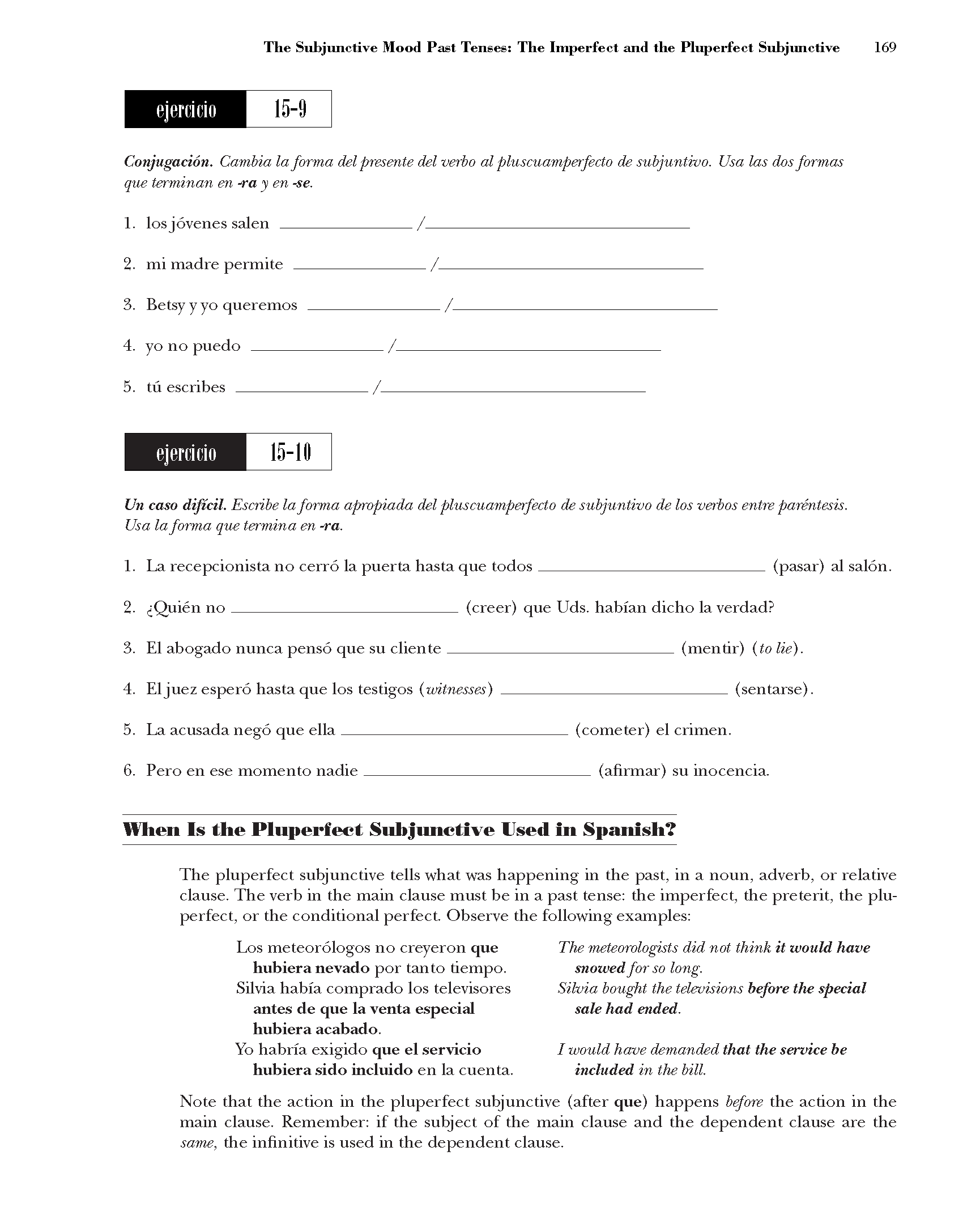CSG180

The Subjunctive Mood Past Tenses: The Imperfect and the Pluperfect Subjunctive
169
ejercicio
15-9
Conjugación. Gambia la forma del presente del verbo al pluscuamperfecto de subjuntivo. Usa las dos formas que terminan en -ra 3! en -se.
1. los jóvenes salen _
2. mi mądre permite _
3. Betsy y yo queremos
4. yo no puedo _
5. tu escribes _
/-
ejercicio
15-10
Un caso dificil. Escńbe la forma apropiada del pluscuamperfecto de subjuntwo de los verbos entre parentesis. Usa la forma que termin a en -ra.
1. La recepcionista no cerró la puerta hasta que todos_
2. <;Quien no_ (creer) que Uds. habian dicho la verdad?
(pasar) al salon.
3. El abogado nunca pensó que su cliente_
4. El juez esperó hasta que los testigos (witnesses)
5. La acusada negó que ella_
(mentir) (tolie). _ (sentarse),
6. Pero en ese momento nadie
(cometer) el crimen.
_ (afirmar) su inocencia.
The pluperfect subjunctive tells what was happening in the past, in a noun, adverb, or relative clause. The verb in the main clause must be in a past tense: the imperfect, the preterit, the pluperfect, or the conditional perfect. Observe the following examples:
Los meteorólogos no creyeron que hubiera nevado por tan to tiempo.
Silvia habia comprado los televisores antes de que la venta especial hubiera acabado.
Yo habria exigido que el servicio hubiera sido incluido en la cuenta.
The meteorologists did not think it would have snowed for so long.
Silvia bought the teleuisions hefore the special sale had ended.
I would hcwe demanded that the seruice be included in the bill.
Notę that the action in the pluperfect subjunctive (after que) happens before the action in the main clause. Remember: if the subject of the main clause and the dependent clause are the same, the infinitive is used in the dependent clause.
Wyszukiwarka
Podobne podstrony:
CSG182 171 The Subjunctive Mood Past Tenses: The Imperfect and the Pluperfect Subjunctive •
CSG184 173 The Subjunctive Mood Past Tenses: The Imperfect and the Pluperfect Subjunctive In real an
CSG174 163 The Subjunctive Mood Past Tenses: The Imperfect and the Pluperfect SubjunctiveThe Imperfe
CSG176 The Subjunctive Mood Past Tenses: The Imperfect and the Pluperfect Subjunctive 165 5. &
CSG178 167 The Subjunctive Mood Past Tenses: The Imperfect and the Pluperfect SubjunctiveOther Uses
CSG182 171 The Subjunctive Mood Past Tenses: The Imperfect and the Pluperfect Subjunctive •
CSG184 173 The Subjunctive Mood Past Tenses: The Imperfect and the Pluperfect Subjunctive In real an
CSG173 Unit 15The 8ubjunotive Mood Past Tenses:The Imperfect and the Pluperfect Snbjnnctive Before l
CSG144 133 The Subjunctive Mood: The Present and the Present Perfect Subjunctive Tenses in Noun Clau
więcej podobnych podstron